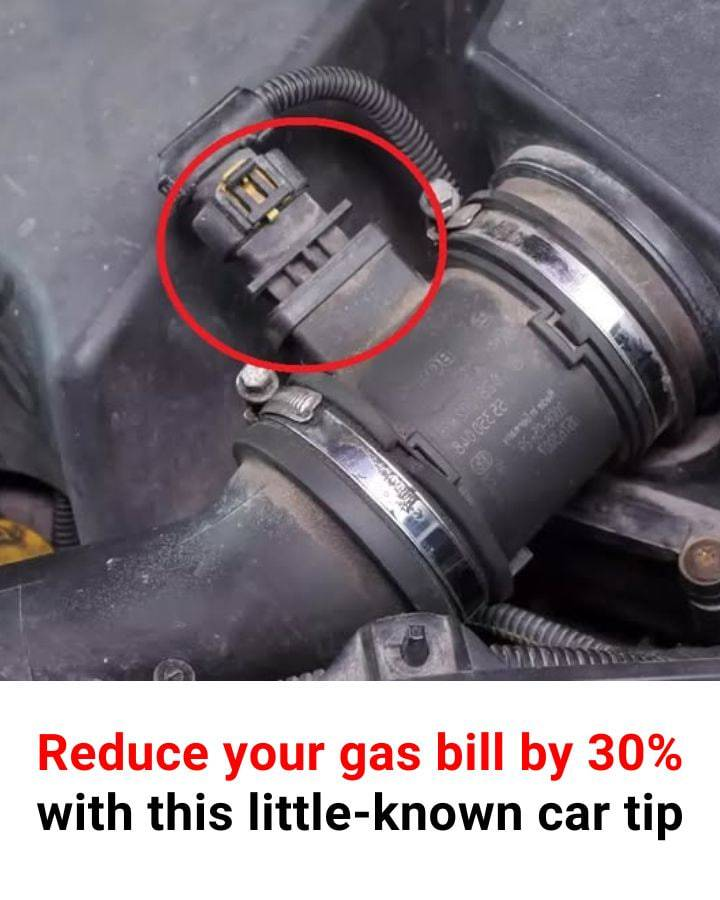The One Simple Fix That Could Save You Hundreds at the Pump
If you’ve been wincing at your gas bill lately, you’re not alone. Fuel prices seem to rise overnight, and every trip to the station feels like a mini financial crisis. But what if we told you there’s a small, often-ignored part of your car that could quietly be eating away at your wallet—and fixing it might cut your fuel bill by up to 30%?
Meet the unsung hero (or villain, if it’s dirty): the mass air flow (MAF) sensor.

What Is the MAF Sensor and Why Should You Care?
The MAF sensor sits in your engine’s air intake system and does one very important job—it measures the amount of air entering the engine and sends that data to your vehicle’s brain, the engine control unit (ECU). Based on that reading, the ECU adjusts how much fuel to inject.
When the MAF sensor is clean and functioning properly, your car runs like a dream—smooth acceleration, efficient fuel usage, and better performance. But when it’s dirty or faulty? Think of it like baking a cake with the wrong amount of ingredients. The whole recipe falls apart.
How a Faulty MAF Sensor Wastes Your Fuel
Here’s the deal: when the MAF sensor gets clogged with dirt, oil, or debris (which it often does over time), it sends bad info to the ECU. The engine then burns more fuel than needed, often without you even noticing until your wallet starts to hurt.
Video: 5 SIMPLE tips to maximize fuel economy #shorts
Symptoms include:
- Poor fuel economy
- Sluggish performance
- Black smoke from the exhaust
- Engine misfires
- Rough idling
If any of that sounds familiar, your MAF sensor might be crying for help.
Real-World Results: Small Fix, Big Savings
Let’s talk numbers. A 2012 Toyota Corolla owner cleaned their MAF sensor and improved fuel efficiency by nearly 30%—dropping from 12L/100km to 8.5L. A 2015 Ford Focus saw a 22% jump in efficiency after replacing the sensor. Even a basic cleaning on a 2010 Honda Civic brought a 15% performance boost.
These aren’t just flukes. Replacing or cleaning a MAF sensor can offer 5% to 30% better fuel economy depending on the condition of the sensor and the vehicle model. For someone driving 15,000 km annually, that could translate into $200–$400 saved each year, depending on fuel prices and vehicle type.

How to Clean or Replace the MAF Sensor
The good news? It’s easy.
- Buy MAF-specific cleaner – Don’t use household or generic automotive cleaners.
- Unplug and remove the sensor – It’s usually near the air filter box.
- Spray gently – Coat the sensor wires or film with the cleaner. Let it dry completely before reinstalling.
- Still rough? Replace it – A new sensor usually costs under $100 and is worth every penny.
Ten minutes of work could save you hundreds. Think of it like brushing your car’s teeth—simple, necessary, and way cheaper than a major repair.
Video: How to Save Fuel: Air filter & mass airflow sensor #knowyourcar
Fueling Habits That Quietly Drain Your Wallet
While the MAF sensor is a game-changer, don’t stop there. Some everyday fuel station habits may be silently robbing you. Here are a few to ditch today:
- Topping off your tank after the pump clicks? Bad idea. It can damage the vapor recovery system and waste gas.
- Waiting until the weekend to refuel? Prices often spike then. Fill up early in the week.
- Ignoring gas apps? You could be missing the cheapest station by just a few blocks.
- Skipping loyalty programs? Brands like Shell and Exxon offer discounts or cash back. Sign up—it’s free money.
- Letting the fuel light come on? Not only is it risky, but it also strains your fuel pump.
- Paying for premium gas when your car doesn’t need it? That’s a common myth. Most cars run just fine on regular.
- Neglecting tire pressure? Under-inflated tires increase drag and lower MPG. Check them monthly.
- Not using a rewards credit card? Some cards give 2–5% back on gas purchases. That adds up fast.
Make Fuel Efficiency a Habit, Not a Headache
Here’s the truth: saving on fuel isn’t just about finding the cheapest station. It’s about knowing your vehicle, staying proactive, and building smarter habits.
The mass air flow sensor might be small, but it plays a huge role in your car’s health and your fuel budget. Combine that fix with a few smart fueling strategies, and you’ve got a winning formula for long-term savings.

Conclusion: One Tiny Sensor, Big-Time Savings
Let’s recap. Your car’s MAF sensor measures airflow, helping your engine balance fuel and performance. When it’s dirty, everything goes off track—including your fuel economy. Clean it, replace it if needed, and you could slash your gas costs by up to 30%.
Add in a few better habits at the pump—timing, tire checks, loyalty points—and you’ve got a powerful strategy to fight rising fuel prices. It’s not magic. It’s maintenance—and a little know-how.
Start with your MAF sensor. Your wallet will thank you.